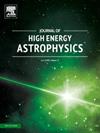Deciphering the multi-wavelength flares of the most distant very high-energy (>100 GeV) γ-ray emitting blazar
IF 10.5
4区 物理与天体物理
Q1 ASTRONOMY & ASTROPHYSICS
引用次数: 0
Abstract
This study analyzes the multi-wavelength flaring activity of the distant flat spectrum radio quasar (FSRQ) OP 313 (z=0.997) during November 2023 to March 2024, using data from Fermi-Large Area Telescope, Swift X-ray Telescope, and Ultraviolet and Optical Telescope. The analysis highlights two significant very high energy (VHE) detection epochs and GeV gamma-ray flaring episodes, providing insight into jet emission processes and radiative mechanisms. We study the evolution of broadband spectral energy distribution (SED) and identify, for the first time, that the source displays three different characteristics in its synchrotron peaks within a short span of four months, which is rather uncommon in FSRQs. Modeling of the multi-wavelength SED with a one-zone leptonic radiative processes attributes the emissions to synchrotron radiation, Synchrotron Self-Compton (SSC), and External Compton (EC) mechanisms, with torus photons as the primary source for EC processes. The results suggest that the gamma-ray emitting region lies outside the broad-line region but within the dusty torus. Furthermore, we find that the radiated power is significantly smaller than the total jet power, suggesting that most of the bulk energy remains within the jet even after passing through the blazar emission zone.
破译最遥远的高能(bbb100 GeV) γ射线发射耀变体的多波长耀斑
利用Fermi-Large Area Telescope、Swift x射线望远镜和紫外光学望远镜的观测数据,分析了2023年11月至2024年3月间遥远平谱射电类星体OP 313 (z=0.997)的多波长耀斑活动。该分析突出了两个重要的甚高能量(VHE)探测时代和GeV伽马射线耀斑事件,为了解喷流发射过程和辐射机制提供了见解。我们研究了宽带光谱能量分布(SED)的演变,并首次发现源在短短四个月内在其同步加速器峰中表现出三种不同的特征,这在fsrq中是相当罕见的。基于单区轻子辐射过程的多波长SED模型将其发射归因于同步辐射、同步自康普顿(SSC)和外部康普顿(EC)机制,其中环面光子是EC过程的主要来源。结果表明,伽马射线发射区域位于宽线区域之外,但在尘埃环内。此外,我们发现辐射功率明显小于总射流功率,这表明即使在穿过耀焰发射区后,大部分大块能量仍留在射流内。
本文章由计算机程序翻译,如有差异,请以英文原文为准。
求助全文
约1分钟内获得全文
求助全文
来源期刊

Journal of High Energy Astrophysics
Earth and Planetary Sciences-Space and Planetary Science
CiteScore
9.70
自引率
5.30%
发文量
38
审稿时长
65 days
期刊介绍:
The journal welcomes manuscripts on theoretical models, simulations, and observations of highly energetic astrophysical objects both in our Galaxy and beyond. Among those, black holes at all scales, neutron stars, pulsars and their nebula, binaries, novae and supernovae, their remnants, active galaxies, and clusters are just a few examples. The journal will consider research across the whole electromagnetic spectrum, as well as research using various messengers, such as gravitational waves or neutrinos. Effects of high-energy phenomena on cosmology and star-formation, results from dedicated surveys expanding the knowledge of extreme environments, and astrophysical implications of dark matter are also welcomed topics.
 求助内容:
求助内容: 应助结果提醒方式:
应助结果提醒方式:


